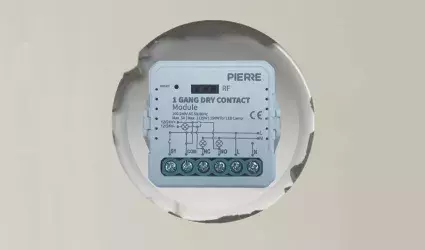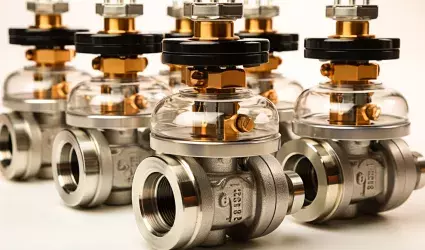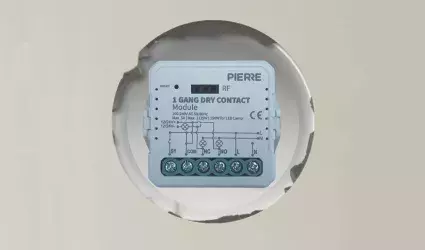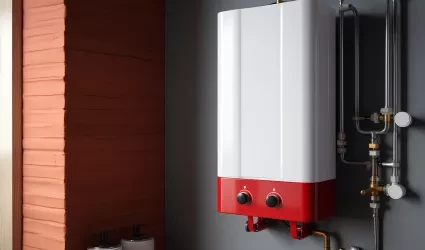On this page
Passive Heatings/Coolings refer to underfloor heating or similar types of heating systems that provide efficient temperature control without the use of a fan. These systems offer precise temperature regulation in individual rooms, making them ideal for maintaining a comfortable climate.
Key Features:
1. Dashboard Control:
- Passive heating and cooling systems can be controlled from the Dashboard, allowing users to easily turn the system On or Off and adjust the temperature settings.
2. Edit Settings:
- By long-pressing the Passive Heating/Cooling card on the Dashboard, users can access additional tabs such as Mode (heating/cooling), Edit, Automation, and Used In. The Used In tab provides a list of all automations where this I/O device is used, allowing for easy tracking and management of automations.
3. Hysteresis:
- The system includes hysteresis settings, which allow users to define the range within which the passive heating/cooling system will activate or deactivate, preventing unnecessary cycling and maintaining more stable room temperatures.
4. Automation and Sensors:
- Passive heating/cooling systems can be automated based on temperature sensors, humidity sensors, motion detectors, or contact sensors for windows, enabling precise climate control and energy efficiency based on room conditions.
- For example, if the contact sensor on a window sends a signal that the window is open, the Passive heating machine will automatically turn Off to prevent energy waste.
The Passive Heatings/Coolings section provides full control and customization, ensuring that each room in your smart home maintains the desired climate effortlessly and efficiently.
Controlling the Passive cooling/heating is quick and simple, easily managed directly from the Dashboard.
Follow the example of the Floor heating Living room.

Use the +/- buttons to adjust the set temperature. With each tap on these buttons, the temperature increases or decreases according to the pre-set hysteresis level.
The current temperature is displayed with larger white numbers, while the set temperature is shown with smaller grey numbers (when heating/cooling is On).
The Passive/heating status is also shown: a sun icon indicates heating, a snowflake icon indicates cooling.
On the temperature slider, blue represents cooling levels, while orange represents heating levels. A smaller circle on the slider shows the current temperature, while the larger circle represents the set temperature.
A Power button is located in the top right corner of the Passive cooling/heating card, allowing you to easily turn the Passive heating/cooling On or Off.

Tap the Power button to turn the Passive heating/cooling system On.
The Power button’s border lines turn blue.
The set temperature is displayed, and you can adjust the desired temperature.

Tap the Power button to turn the Passive heating/cooling Off.
The Power button turns its border lines to grey.
It is shown current temperature and it is written Heating off or Cooling off.
Use the +/- buttons to adjust the set temperature. With each tap on these buttons, the temperature increases or decreases according to the pre-set hysteresis level.
The current temperature is displayed with larger white numbers, while the set temperature is shown with smaller grey numbers (when heating/cooling is turned On).
On the temperature slider, blue represents cooling levels, and orange represents heating levels. A smaller circle on the slider shows the current temperature, while the larger circle represents the set temperature. Tap the larger circle on the slider and slide it along to adjust the set temperature.
Tap the On button to activate heating or cooling. When heating is set, the sun icon is displayed on the On button. When cooling is set, the snowflake icon is shown. Once activated, the button turns blue.
Tap the Off button to deactivate heating or cooling. When activated, the Off button also turns blue.

To turn the Heating On, tap the button On with icon of the sun.
You can set desired temperature now, that is written with smaller grey numbers by buttons +/-, or by sliding bigger circle on the temperature slider by your finger.
When heating is On, On button turns blue.
Tap Done to confirm.

To turn the Heating Off, tap the button Off.
You cannot set temperature now. It is displayed current temperature, and Heating off.
When heating is Off, Off button turns blue.
Tap Done to confirm.
Editing of Passive cooling/heating is very easy. Follow next steps.

Scroll to the Passive cooling/heating and tap on the desired Passive cooling/heating from the list.
In this case on the Passive cooling/heating Living room.

Tap on the Edit tab and edit following form.
Edit the following form:
- Name - Edit the name of the Passive heating/cooling system.
- Photo - Choose the source for the photo.
- Slide to confirm - When enabled, you'll be prompted to confirm actions to avoid accidental actions.
- Mode - Select either heating or cooling by tapping the corresponding radio button.
- Minimum temperature - Set this value by tapping the +/- buttons.
- Maximum temperature - Set this value by tapping the +/- buttons.
- Target step - Specify the step value for increasing or decreasing the target temperature by tapping +/-.
- Temperature format - Choose between Fahrenheit or Celsius by tapping the respective radio button.
- Temperature sensor - Select the temperature sensor by tapping on it.
Tap Submit/Done to save your changes.

Tap the photo of the Passive heating/cooling. You have three options:
- Open Library - The phone’s Library will open.
- Open Camera - You can take a picture using your smartphone.
- Choose default image - These images are prepared in advance for a seamless experience.

Tap on the radio button next to the desired Temperature sensor from the list.
To confirm tap Save/Done.
If the temperature, detected by the Temperature sensor, falls below 20°C (the desired threshold for comfort), the floor heating Valve opens to allow warm water flow and activate the system. Additionally, if a Magnet window sensor detects an open window, the Valve will automatically close to conserve energy by stopping the heating. This automation can be configured to run during specific hours, for example, between 6 AM and 10 PM, ensuring optimal energy efficiency and comfort.

Open the Dashboard, find the Passive heating/cooling, and long press on its card.

In the Menu, under Settings, tap on the I/O.

Scroll to the Passive cooling/heating and tap on the desired Passive cooling/heating from the list.
In this case on the Passive cooling/heating Living room.

Tap on the tab Automation and then on +Add new Automation.
The Used In tab shows all the scenarios and automations where Passive heating/cooling is applied, making it easy to see where this I/O is used without the need to search manually. If it isn't used in any, the list will be empty, and a message will display: "This I/O is not in use anywhere." This feature is particularly useful as it consolidates all relevant information in one place.

In this case, Passive heating/cooling, example - Floor Heating Living room is used in the scenario Coming home.





